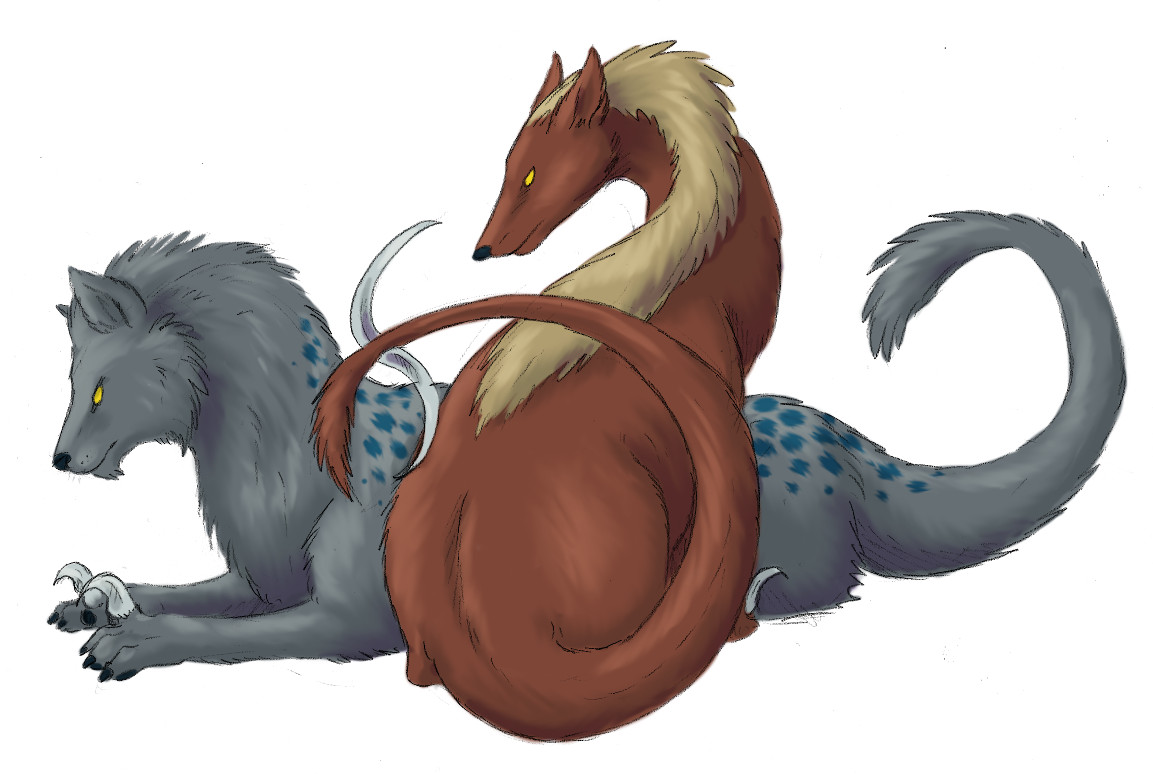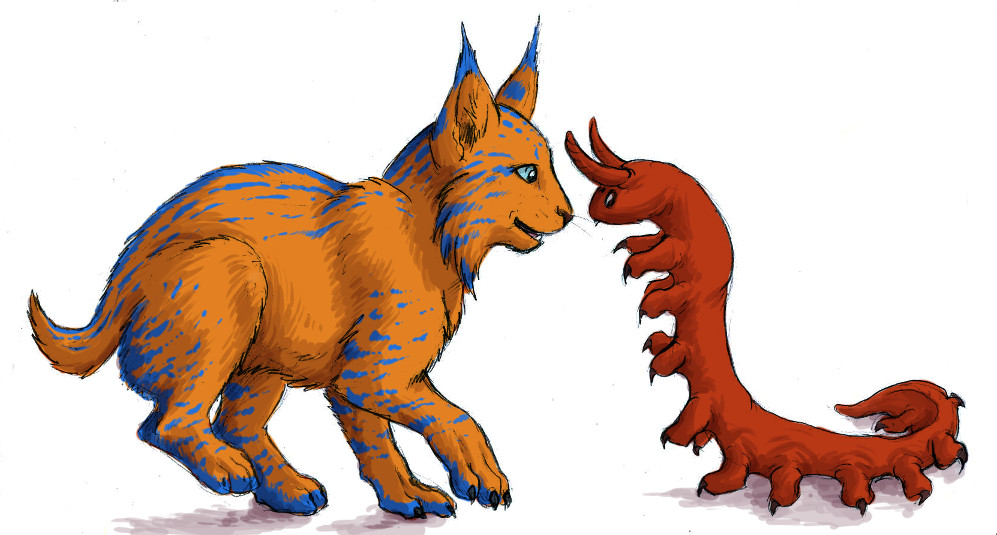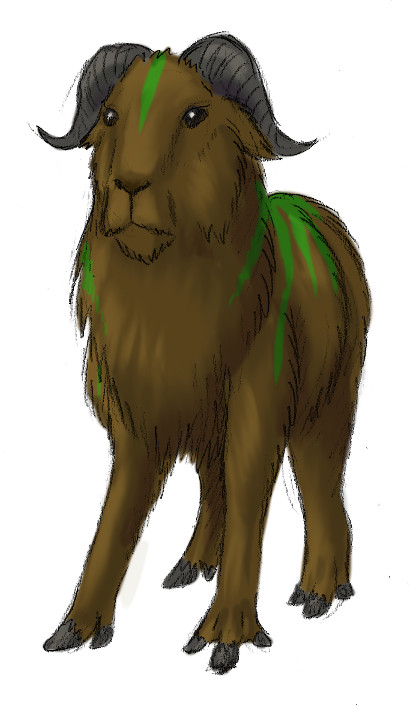Ryll is full of all sorts of different critters. Some are prey for the kiarrcats, some are predators, and some are companions. Here are just a few examples.
Kessi
The kessi are a species of small cats native to the forests of Morou. They are generally held to be the ancestors of the kiarrcats, or at least a close relative. In the legend of the Archetypes, it is said that they are the raw material from which the Archetype Spirits fashioned their sapient children. They live in small groups and have sometimes been observed to use simple tools. Essentially, these are the kiarrcat versions of apes - a bright animal, hovering on the threshold of full intelligence. Kessi females give birth to one to three cubs at a time, which are raised and taught by the entire group. They can live for about thirty years.
Mri

The mri aren't really a species, but a full clade. The average mri is a small to medium sized creature, similar to Earth's mammal-like-reptiles in the Permian period, with a short coat, semi-reptilian face, whiskers, a tapering tail, and three-toed feet. The inner toe of each forefoot is usually modified into a long claw for grooming and defence. Mri are largely herbivorous, though they can digest meat and will scavenge from carcasses if the opportunity arises.
There are many different mri species, spread out across the face of Ryll. The smallest is a tiny scurrying creature the size of a mouse, the largest is twice the size of an adult Polar. The range of shapes is impressive. There are armoured species, swift running species, horned species, social and solitary species - with all of their diversity, mri can be found everywhere on Ryll. They are a staple food source for the kiarrcats and some species are herded or domesticated.
Like reptiles, mri lay soft shelled eggs and do not give milk. Clutch sizes are just as variable as the mri themselves - up to twenty for small species, and only a few for larger. The biggest species lay only one well protected egg at a time. Female mri have a pouch to carry and incubate their eggs, but some species build nests and the pouch is greatly reduced. Most mri care for their young after hatching, though some species put in more work than others. Lifespans range from a couple of years for the smallest mri, to several decades for the biggest.
Mrrit

The mriit is a medium sized predator, distantly related to the mri. It lives in packs and is Ryll's equivalent to a wolf. Mrrit are common across the face of Ryll, and there are multiple subspecies, each adapted to where it lives. Mrrit are competitors for food to kiarrcats, and sometimes a danger - they generally avoid the magic-wielding felines, but may pick off young cubs or the elderly if other game is scarce. Even so, some kiarr keep them as pets, although to do so a cub must be caught when very young and raised with kiarr, so it accepts them as its pack.
Nirith

Rouen is famed for its large invertebrates, and this is no exception. The nirith is a soft bodied creature similar to Earth's velvet worms, only much bigger. Native to the Rouen jungles, wild nirith live in packs headed by a dominant female. They are carnivores, and hunt by trapping their prey in silk. Domesticated nirith are found worldwide as pets and guardians. They are loyal companions and working animals alike. The silk producing ability has been bred out of companion varieties, though it is retained in guard breeds to help them catch intruders. Some breeds have even been bred to produce more silk than normal, which is then woven into fine cloth. Nirith silk is a valuable trade item, though it is used for decoration, not warmth.
Ourush
These relatives of sesshu live on Hrimroul's steppes, taigas, and tundras. They're bigger than sesshu and very hairy, like a muskox or a yak. Ourush are always on the move, looking for new grazing. They're wild animals, but the herds are trailed by local kiarr, and some have become semi-domesticated.
Rouen Bee
Another of Rouen's well known exports, the Rouen bee resembles nothing more than a giant, football sized bumblebee, though it lives in long-lived hives like a honeybee. Rouen bees can be very dangerous. Their stings are potent, and can cause hallucinations, coma, or death. Thankfully they are also docile and don't sting unless they feel threatened, which is good news, as their honey is very popular - rich tasting, though a little soporific. These bees live wild in Rouen's southeastern jungles, but the domesticated variety has been exported worldwide. They are usually kept by experienced keepers, who know how to calm the bees so they aren't provoked to sting. It's a dangerous job sometimes, but the rewards are well worth it.
Sesshu

This is a large, horned rodent that lives on the Hrimroul savannahs. They resemble capybaras, but much larger, with horns and hooves. They are about half again as big as an adult Savannah kiarrcat, and are one of their favourite prey creatures. Sesshu are herd based grazers, rather like cattle. Like cattle they give milk, and some Savannah villages that have managed to domesticate them now trade in a novelty food - sesshu cheese.
Yorou
The yorou is a large amphibian that has evolved to tolerate saltwater. Resembling a salamander, the yorou is about the size of an adult Water and is found all across Ryll's tropical seas. They appear to migrate, but nobody has yet charted their migratory patterns in full. When they are ready to breed, yorou seek shelter in secluded coves. The female carries the eggs and developing young in her mouth, during which time she does not feed. When they have metamorphosed into their adult form, the group disperse and swim out into the open ocean. Yorou can walk on land for short distances, but they are very clumsy and usually only walk to get back into the water if they find themselves beached.
Yorou feed on soft bodied invertebrates such as jellyfish and are no threat to a kiarrcat, though a curious individual might nudge up to a swimming kiarr, only to leave when it realises it isn't food. Kiarrcats themselves usually leave them alone as their flesh and skin are poisonous if ingested. Yorou have bright warning colours to make that clear to any would-be predators, and these striking patterns mean that yorou-watching is a popular pasttime in tropical inlets during the breeding season. Not only are they beautiful to look at, but when attracting a mate they give off low tones that are said to have a calming effect on observers.
